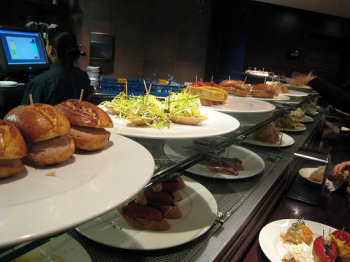The First Timer's Guide to Tapas Etiquette
 One of the top Spanish dining experiences on any tourist’s list will be indulging in a traditional tapas crawl. The dining ritual most often associated with Spain, the tapas crawl is the pre-dinner (or sometimes, dinner substitute) traditional of hopping from bar to bar and having a few bites of food and a drink at each one. For some first timers, it can be a little confusing. How much food will I receive? How much will it cost? Do I serve myself or place an order? Here’s a guide to figuring it all out.
One of the top Spanish dining experiences on any tourist’s list will be indulging in a traditional tapas crawl. The dining ritual most often associated with Spain, the tapas crawl is the pre-dinner (or sometimes, dinner substitute) traditional of hopping from bar to bar and having a few bites of food and a drink at each one. For some first timers, it can be a little confusing. How much food will I receive? How much will it cost? Do I serve myself or place an order? Here’s a guide to figuring it all out.
What are tapas?
Tapas are small bites that can vary widely in style depending on where you’re enjoying them. In the Rioja region, for example, they tend to be simpler – perhaps just a skewer of perfectly marinated grilled shrimp and pineapple or a heaping bowl of steaming patatas bravas with a spicy sauce – but no less delicious, while in San Sebastian, they are more often tiny representations of haute cuisine meals. Ingredients used here often include delicacies like foie gras, lobster, and grilled lamb. Along the coast they’ll incorporate more seafood, while small central areas usually use more meat. Some restaurants serve a wide selection of tapas while others concentrate on making one dish better than anyone else.
Enjoying a tapas crawl is a great way to experience some local culture and try some regional dishes at a low price.
What are the different styles of tapas bars?
Tapas bars can be surprisingly varied. Some are veritable holes in the wall – with only a chalkboard menu (or no menu!), standing room at the bar or maybe a few wine barrels to congregate around outside – and others are much more polished and trendy affairs where you’ll sit and order off a menu, be served by a waiter, and have your food prepared to order.
What’s the protocol?
As the style of tapas bar ranges, so does the protocol. At some, you simply grab a plate, load it up with what you want, and when you are done, just tell the bartender what you had. At others, order from the bartender, who will plate the tapas for you, and then tally up your cost at the end by counting the number of toothpicks on your plate. And at still others, you’ll sit and order from a waitperson and then be brought an itemized bill at the end. How do you know what kind of bar you are at? Well, you just have to pay attention.
It’s easy to tell if you’re at a sit-down, order from a menu, kind of place. The other distinctions aren’t as easy. When you first walk in, take stock of your surroundings. Are the tapas out on the counter on plates, or are they on the counter in a glass case. Case = bartender serves you. If they’re out on the bar where anyone can grab them, check to see if there are plates next to the display. If so, you can simply ask the bartender for “un plato” and see what happens – if he hands you one, help yourself. If not, tell him what you want. Don’t be shy about getting the bartender’s attention, especially at the more crowded bars. Just catch his eye and call out your order quickly.
At some places, cold tapas are set out for self service, while hot tapas and racíones (larger portions of items like calamari and patatas bravas) will be made to order. If these aren’t on display behind a glass case, look around for a menu written on a wall or chalkboard. You can order these from the bartender.
How do I know the cost?
Most tapas bars still operate on the honor system. If your tapas were served on toothpicks, do not remove them from your plate – this is how the bartender will tally up your bill. If not, just tell him or her what dishes you had and he or she will calculate the cost. Respect the honor system, and don’t try to cheat. Most tapas are very cheap anyways. Each round of tapas with one drink should cost no more than a few euros.
Depending on where you go, your bartender may speak English. This is more likely in a large city as opposed to a small town, but either way it’s always helpful to know a few key phrases to help you order.
Racíon, or racíones– larger-size portions of tapas, usually how calamari or patatas bravas are served
Plato – plate
bacalao – cod
bocadillos – sandwiches
boquerones – anchovies
calamares – calamari (fried squid rings)
champinones – mushrooms
croquettas – deep fried balls of dough and items like ham and cheese or shrimp
gambas – prawns
or jamon y queso – ham and cheese
mejillones – mussels
patats bravas – potato (baked or fried) topped with a spicy sauce
pollo– chicken
pinxtos –(“pinchos”) the Basque word for tapas
pulpo – octopus
tortilla– baked omelette, usually with onions, served cold
Photo by fritish